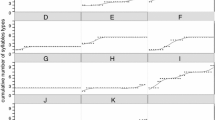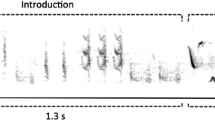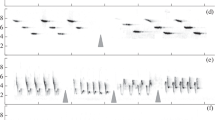Abstract
Distinct song types that constitute the song repertoire can be identified in the singing of males of many passerine bird species. Song repertoires and the organization of singing in two Chinese species of leaf warblers (the large-billed leaf warbler and the sulfur-breasted leaf warbler) have been compared. The songs of both species are simple and belong to the common “archetype”, and the size of the individual song repertoire is usually small (6–7 song types in the former species and 7–9 in the latter). The time-and-frequency parameters of the notes that constitute the songs (five notes in each song) have been measured, and Euclidean distances between all song types of a specific male and a single species have been calculated using the data. The similarity (as inferred from Euclidean distances) between the songs in each individual large-billed leaf warbler male was almost twice higher than that between the songs of the sulfur-breasted leaf warbler individuals. Moreover, transitions to a song of a different type during singing (song type switching) were more frequent in large-billed leaf warblers. A negative correlation between the average Euclidean distance between all songs of an individual and the frequency of song type switching has been discovered. Males of certain bird species reportedly show a stronger reaction to song type switching than to switching between the versions of songs that show higher similarity (song types can be subdivided into variants in some species). Therefore, we assumed that large-billed leaf warblers are “compelled” to switch the song type more often in order to compensate for the scarcity of the code related to considerable similarity of songs of the different types.
Similar content being viewed by others
References
Alström, P., Olsson, U., and Lei, F., A review of the recent advances in the systematic of the avian superfamily Sylvioidea, Chinese Birds, 2013, vol. 4, pp. 99–131.
Beecher, M.D., Campbell, S.E., Burt, J.M., Hill, C.E., and Nordby, J.C, Song-type matching between neighboring song sparrows, Anim. Behav., 2000, vol. 59, pp. 21–27.
Briefer, E., Osiejuk, T., Rybak, F., and Aubin, T.,Are bird song complexity and song sharing shaped by habitat structure? An information theory and statistical approach, J. Theor. Biol., 2010, vol. 262, pp. 151–164.
Burt, J.M. and Beecher, M.D., The social interaction role of song in song sparrows: implications for signal design, 2008, vol. 3, pp. 86–98.
Catchpole, C.K. and Slater, P.J.B., Bird Song: Biological Themes and Variations, Cambridge Univ. Press, 2008.
Falls, J.B. and D’Agincourt, L.G, Why do meadowlarks switch song types?, Can. J. Zool., 1982, vol. 60, pp. 3400–3408.
Garamszegi, L.Z., Balsby, T.J.S., Bell, B.D., Borowiec, M., Byers, B.E., et al., Estimating the complexity of bird song by using capture–recapture approaches from community ecology, Behav. Ecol. Sociobiol., 2005, vol. 57, pp. 305–317.
Kramer, H.G., Lemon, R.E., and Morris, M.J, Song switching and agonistic stimulation in the song sparrow (Melospiza melodia): five tests, Anim. Behav., 1985, vol. 33, pp. 135–149.
Langmore, N.E, Song switching in monandrous and polyandrous dunnocks, Prunella modularis, Anim. Behav., 1997, vol. 53, pp. 757–766.
Martens, J., A preliminary review of the leaf warbler genera Phylloscopus and Seicercus, in Systematic Notes on Asian Birds, Wells, D.R, Ed, Brit. Orn. Club Occas. Publ., 2010, no. 5, pp. 41–116.
Molles, L.E, Singing complexity of the banded wren (Thryothorus pleurostictus): do switching rate and song-type diversity send different message?, Auk, 2006, vol. 123, pp. 991–1003.
Nelson, D.A. and Marler, P.,Categorical perception of a natural stimulus continuum: birdsong, Science, 1989, vol. 244, pp. 976–978.
Okanoya, K., Finite–state song syntax in Bengalese finches: sensorimotor evidence, developmental processes, and formal procedures for syntax extraction, in Birdsong, Speech, and Language: Exploring the Evolution of Mind and Brain, Bolhuis, J.J. and Everaert, M., Eds., Cambridge, MA: MIT Press, 2013, pp. 229–242.
Opaev, A.,The relationships between repertoire size and organization of song bouts in grey-crowned warblers Seicercus tephrocephalus, J. Ornithol., 2016. doi 10.1007/s10336- 016-1342-6
Podos, J., Peters, S., Rudnicky, T., Marler, P., and Nowicki, S.,The organization of song repertoire in song sparrows: themes and variation, Ethology, 1992, vol. 90, pp. 89–106.
Prather, J.E., Nowicki, S., Anderson, R.C., Peters, S., and Mooney, R.,Neural correlates of categorical perception in learned vocal communication, Nat. Neurosci., 2009, vol. 12, pp. 221–228.
Riebel, K. and Slater, P.J.B, Testing the flexibility of song type bout duration in the chaffinch, Fringilla coelebs, Anim. Behav., 2000, vol. 59, pp. 1135–1142.
Scharff, C. and Nottebohm, F., A comparative study of the behavioral deficits following lesions of various parts of the zebra finch song system: implication for vocal learning, J. Neurosci., 1991, vol. 11, pp. 2896–2913.
Searcy, W.A. and Yasukawa, K.,Use of the song repertoire in intersexual and intrasexual context by male red-winged blackbirds, Behav. Ecol. Sociobiol., 1990, vol. 27, pp. 123–128.
Searcy, W.A., Podos, J., Peters, S., and Nowicki, S.,Discrimination of song types and variants in song sparrows, Anim. Behav., 1995, vol. 49, pp. 1219–1226.
Searcy, W.A., Anderson, R.C., and Nowicki, S.,Bird song as a signal of aggressive intent, Behav. Ecol. Sociobiol., 2006, vol. 60, pp. 234–241.
Stoddard, P.K., Beecher, M.D., and Willis, M.S, Response of territorial male song sparrows to song types and variations, Behav. Ecol. Sociobiol., 1988, vol. 22, pp. 125–130.
Author information
Authors and Affiliations
Corresponding author
Additional information
Original Russian Text © Y.A. Kolesnikova, A.S. Opaev, 2016, published in Zoologicheskii Zhurnal, 2016, Vol. 95, No. 10, pp. 1207–1217.
Rights and permissions
About this article
Cite this article
Kolesnikova, Y.A., Opaev, A.S. Differences in song repertoire organization in two leaf warbler species (Phylloscopidae), the large-billed leaf warbler (Phylloscopus magnirostris) and the sulfur-breasted leaf warbler (Phylloscopus ricketti). Biol Bull Russ Acad Sci 43, 1239–1248 (2016). https://doi.org/10.1134/S1062359016110091
Received:
Published:
Issue Date:
DOI: https://doi.org/10.1134/S1062359016110091




